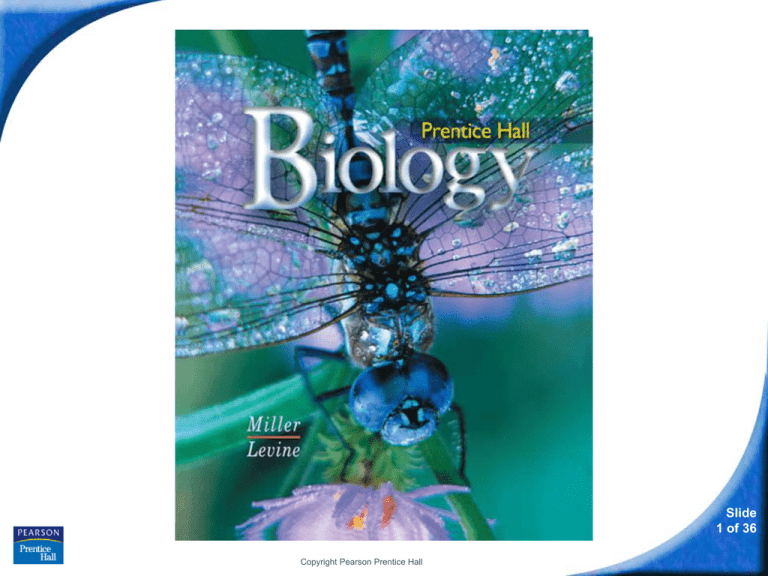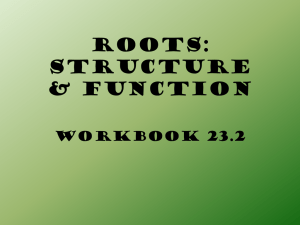
Biology
Slide
1 of 36
Copyright Pearson Prentice Hall
Angiosperms—Flowering Plants
Slide
2 of 24
Copyright Pearson Prentice Hall
Diversity of Angiosperms
What are monocots and dicots?
Slide
3 of 36
Copyright Pearson Prentice Hall
Diversity of Angiosperms
1. Characteristics of Angiosperms—flowering plants
Slide
4 of 36
Copyright Pearson Prentice Hall
Diversity of Angiosperms
Slide
5 of 36
Copyright Pearson Prentice Hall
Diversity of Angiosperms
Monocots include corn, wheat, lilies,
orchids, and palms.
Dicots include roses, clover, tomatoes,
oaks, and daisies.
Slide
6 of 36
Copyright Pearson Prentice Hall
23–2 Roots
Slide
7 of 36
Copyright Pearson Prentice Hall
23–2 Roots
Types of Roots
Types of Roots
What are the two main types of roots?
Slide
8 of 36
Copyright Pearson Prentice Hall
23–2 Roots
Types of Roots
1. 2 main types of roots are:
A. taproots: primary root grows long
-mainly in dicots
- carrot is an example
Fibrous Roots
Taproot
Slide
9 of 36
Copyright Pearson Prentice Hall
23–2 Roots
Types of Roots
b. fibrous roots:
•Branch, no single
root grows larger
than the rest.
•mainly in
monocots
*found in grasses.
Fibrous Roots
Slide
10 of 36
Copyright Pearson Prentice Hall
23–2 Roots
Root Structure and Growth
What are the main tissues in a mature
root?
Slide
11 of 36
Copyright Pearson Prentice Hall
23–2 Roots
Root Structure and Growth
1. the epidermis
2. central cylinder of vascular tissue
3. Ground tissue
*The root system plays a key role in
water and mineral transport.
Slide
12 of 36
Copyright Pearson Prentice Hall
23–2 Roots
Root Structure and Growth
2. root hairs:
* covers root’s surface
*provide large surface
area which water can
enter the plant.
Root
hairs
Slide
13 of 36
Copyright Pearson Prentice Hall
23–2 Roots
3. epidermis:
protects the root
and absorbs water.
Root Structure and Growth
Epidermis
Slide
14 of 36
Copyright Pearson Prentice Hall
23–2 Roots
Root Structure and Growth
4. cortex:
*Inside the
epidermis
Ground
tissue
(cortex)
* layer of ground
tissue
Slide
15 of 36
Copyright Pearson Prentice Hall
23–2 Roots
5. endodermis:
encloses the
vascular cylinder
Root Structure and Growth
Endodermis
Slide
16 of 36
Copyright Pearson Prentice Hall
23–2 Roots
Root Structure and Growth
6. vascular cylinder:
central region of root
that includes the
xylem and phloem.
Vascular cylinder
Phloem
Xylem
Slide
17 of 36
Copyright Pearson Prentice Hall
23–2 Roots
Root Structure and Growth
(Roots grow in length as
their apical meristem
produces new cells near
the root tip.)
Apical meristem
Slide
18 of 36
Copyright Pearson Prentice Hall
23–2 Roots
Root Structure and Growth
7. root cap :
*covers new cells
* protects the root as it
forces its way through the
soil.
Apical meristem
Root cap
Slide
19 of 36
Copyright Pearson Prentice Hall
23–2 Roots
Root Functions
Root Functions
(What are the different functions of roots?
Slide
20 of 36
Copyright Pearson Prentice Hall
23–2 Roots
Root Functions
Roots anchor a plant in the ground and
absorb water and dissolved nutrients from
the soil.
Slide
21 of 36
Copyright Pearson Prentice Hall
23–2 Roots
Root Functions
Uptake of Plant Nutrients
To grow, flower, and produce seeds, plants need a
variety of inorganic nutrients in addition to carbon
dioxide and water.)
Slide
22 of 36
Copyright Pearson Prentice Hall
23–2 Roots
Root Functions
8. most important nutrients plants need:
• nitrogen
• phosphorus
• potassium
• magnesium
• calcium
Slide
23 of 36
Copyright Pearson Prentice Hall
23–2 Roots
Root Functions
9. Active Transport of Minerals:
a. Osmosis and active transport move water and
minerals from the root epidermis into the cortex.
Slide
24 of 36
Copyright Pearson Prentice Hall
23–2 Roots
Root Functions
b. Transport proteins use ATP to pump mineral ions
from the soil into the plant.
Root hairs
Slide
25 of 36
Copyright Pearson Prentice Hall
23–2 Roots
Root Functions
c. high concentration of mineral ions in plant cells
causes osmosis (water molecules to move into the
plant by.)
d. Root pressure is the starting point for movement of
water through the vascular system of the entire plant
Slide
26 of 36
Copyright Pearson Prentice Hall
23–2 Roots
Root Functions
The endodermis is composed of many individual
cells.
Endodermis
Slide
27 of 36
Copyright Pearson Prentice Hall
23–2 Roots
Root Functions
Each cell is surrounded on four sides by a waterproof
strip called a Casparian strip.
Casparian strip
Casparian
strip
Slide
28 of 36
Copyright Pearson Prentice Hall
23–2 Roots
Root Functions
The Casparian strip prevents the backflow of water
out of the vascular cylinder into the root cortex.
Slide
29 of 36
Copyright Pearson Prentice Hall
23–2 Roots
Root Functions
Water moves into the vascular cylinder by
osmosis.
Because water and minerals cannot pass through
the Casparian strip, once they pass through the
endodermis, they are trapped in the vascular
cylinder.
As a result, there is a one-way passage of
materials into the vascular cylinder in plant roots.
Slide
30 of 36
Copyright Pearson Prentice Hall
23–2 Roots
Root Functions
Root Pressure
As minerals are pumped into the vascular cylinder,
more and more water follows by osmosis,
producing a strong pressure.
This root pressure forces water through the
vascular cylinder and into the xylem.
Slide
31 of 36
Copyright Pearson Prentice Hall
23–2 Roots
Root Functions
As more water moves from the cortex into the
vascular cylinder, more water in the xylem is forced
upward through the root into the stem.
Root pressure is the starting point for movement of
water through the vascular system of the entire plant.
Slide
32 of 36
Copyright Pearson Prentice Hall
23–2
Click to Launch:
Continue to:
- or -
Slide
33 of 36
Copyright Pearson Prentice Hall
23–2
Taproots are more common than fibrous roots in
a. monocots.
b. dicots.
c. neither monocots or dicots.
d. both dicots and monocots.
Slide
34 of 36
Copyright Pearson Prentice Hall
23–2
The cells in a root that divide are found in the
a. apical meristem.
b. epidermis.
c. endodermis.
d. vascular cylinder.
Slide
35 of 36
Copyright Pearson Prentice Hall
23–2
The tough layer of cells that covers the root tip is
called the
a. vascular cylinder.
b. root cap.
c. ground tissue.
d. apical meristem.
Slide
36 of 36
Copyright Pearson Prentice Hall
23–2
Xylem and phloem are found in the
a. epidermis.
b. endodermis.
c. apical meristem.
d. vascular cylinder.
Slide
37 of 36
Copyright Pearson Prentice Hall
23–2
Roots absorb minerals from the surrounding soil
by
a. diffusion.
b. active transport.
c. passive transport.
d. root pressure.
Slide
38 of 36
Copyright Pearson Prentice Hall
END OF SECTION







